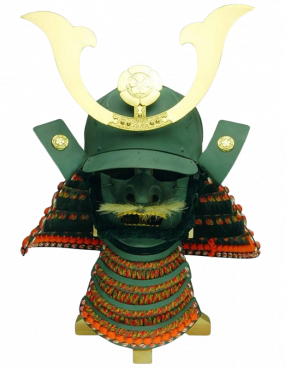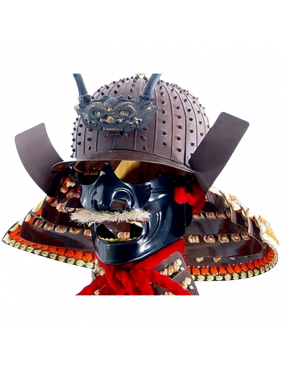This Japanese samurai armor, a museum-quality replica inspired by Oda Nobunaga, a pivotal figure in feudal Japan, showcases exceptional craftsmanship and historical accuracy. Styled in Yukinoshita Do, it features solid vertical plates around the torso, characteristic of the Sengoku period. The helmet bears Nobunaga's crest, and the armor comes with a traditional lacquered box and wooden display frame. Standing at 1.68 meters tall, this life-size armor is both a historical tribute and a striking display piece, reflecting Nobunaga’s strategic brilliance during his unification campaigns.
Features:
- Height: 1.68 m
- Style: Yukinoshita Do
- Included Elements: Full armor, lacquered box, display frame
- Associated Figure: Oda Nobunaga (1534-1582), unifier of Japan
Total weight: 30kg
Oda Nobunaga is one of the most significant figures in Japanese feudal history. Born in 1534 in the province of Owari, he came from a family of daimyos (warlords). Nobunaga is known for playing a crucial role in ending the Sengoku period (1467-1615), an era marked by constant wars between rival clans.
Key Stages of His Life:
-
Rise to Power:
After his father's death, Nobunaga became the leader of the Oda clan in 1551. He quickly consolidated his power by eliminating internal rivals and defeating more powerful enemies, such as the Imagawa clan, at the decisive Battle of Okehazama in 1560, which marked the beginning of his rise.
-
Unification of Japan:
Nobunaga adopted an expansionist policy aimed at unifying Japan under his rule. He employed innovative military tactics, including the large-scale introduction of firearms, revolutionizing traditional combat methods.
-
Modernization and Reform:
Beyond his military achievements, Nobunaga implemented economic and administrative reforms. He promoted trade, limited the influence of warrior monks, and worked towards a more centralized and stable society.
-
Alliances and Rivalries:
Nobunaga formed strategic alliances with other daimyos, notably Tokugawa Ieyasu. However, his ruthless leadership style earned him many enemies, including some of his own generals.
-
Tragic End:
In 1582, Oda Nobunaga was betrayed by his general Akechi Mitsuhide and died during the Incident at Honnō-ji Temple in Kyoto, where he was forced to commit suicide (seppuku). His death marked a turning point in Japanese history, but his dream of unifying Japan was continued by his successors, Toyotomi Hideyoshi and Tokugawa Ieyasu.
Legacy:
Oda Nobunaga is often considered the first of Japan’s three "great unifiers." His military, political, and economic reforms left a lasting legacy, making him an iconic figure in Japan’s transition from the medieval to the modern era.
 Security payment
Security payment
 Terms and conditions of sale
Terms and conditions of sale




























